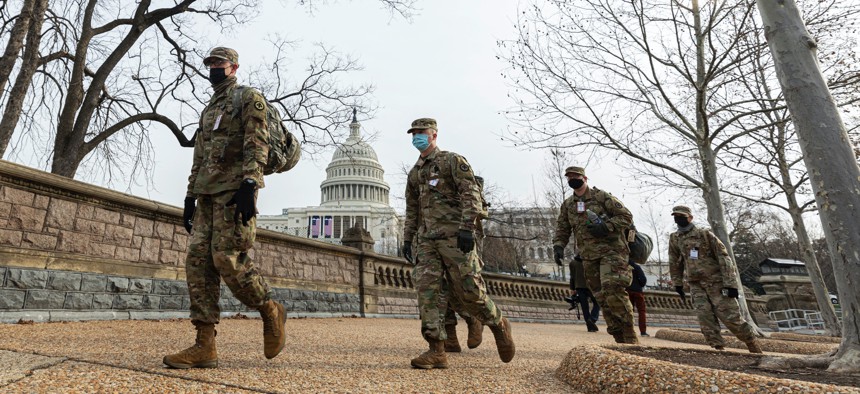
National Guardmen on U.S. Capitol security detail. Several other Guardsmen were removed after extra screening for potential extremists in the ranks. U.S. Air National Guard / Master Sgt. Matt Hecht
How to Root Out Extremism in the US Military
Start by figuring out how pervasive the problem is.
The long-simmering problem of extremists among U.S. military personnel boiled over on Jan. 6, when people serving in the military and veterans were among those who stormed the U.S. Capitol Building. The Justice Department is working to hold these individuals accountable, and those actively in the service may face military prosecution. But the military also has to tackle the underlying issues at play and do more to understand and address extremism in the service.
At a strategic level, the military is fighting this battle blind. Only two studies have been commissioned to look at this problem specifically — one in the active-duty Army and one in the Air National Guard — and both are more than two decades old. Like sexual harassment, extremism among the troops may not be reported; its pervasiveness may not be evident until one goes looking.
There are hints the military is starting to pay attention again. After a Military Times survey of active-duty troops suggested that white supremacy and extremism on the rise, respected former leaders — among them, Marine commandant-turned-national security adviser James Jones — called on the Pentagon to do more. In December, a Defense Department report on diversity issues called for more effectively prohibiting extremist and hate group activity and expanding the Uniform Code of Military Justice to address it. A DoD plan of action with specific milestones is expected at the end of June.
Defense leaders say there is zero tolerance for extremism in the military. DoD-wide and service-specific policies in the Army, Navy, Air Force, and Marine Corps already prohibit extremist activity. And extremism is intrinsically contrary to good order and discipline of military units: effective military leaders should naturally be opposed to individuals who seek to subjugate classes of people, disrespect the rule of law, espouse hatred, and isolate themselves from their communities. But establishing policies and enforcing them are two different things.
Ultimately, the war to root out extremism is going to be fought in the trenches by individual military commanders and against specific bad apples. These leaders need the tools and training to spot and deal with extremism in the ranks.
To begin, those entering the service need to be screened for extremist views so that the services do not provide military training to those intent on harming their fellow Americans.
Commanders need to be made aware of extremist behavior so that they might recognize it and learn to confront it. These conversations may be uncomfortable because others are sympathetic to similar but milder sentiment, or because extremist language is coded or brushed off, but that can be no excuse. Nor can commanders excuse extremism because a soldier performs their duties otherwise sufficiently.
Indeed, all servicemembers should understand their duty to report such behavior and such reports need to prompt a firm response with accountability. There must be broad acceptance that one cannot espouse extremism and be “a good soldier.” One cannot be an American patriot and seek to use violence to deprive fellow citizens of their civil rights or advance hatred towards them; these ideals are incompatible.
Veterans also need special attention. NPR found that among the 140 people charged thus far in the Jan. 6 attack, nearly one-fifth were veterans, more than double veterans’ proportion of the general population.
Earlier research suggests that far-right extremists disproportionately possess military experience. We need to know why. Some speculate that veterans are targeted for recruitment by white supremacist and far-right groups. But there could be other reasons. Was trauma left untreated? Are some veterans predisposed to these beliefs because they are more tolerant of violence than the general population? Were some individuals separated from the military precisely because they held extremist views? And could discharge — with its loss of a job and sense of identity — put them at greater risk of radicalization? To counter extremist networks targeting our military and veterans, we must also understand those networks generally.
We need to recognize that the military cannot fully eradicate a scourge that is breeding and expanding around it. The military has a growing extremism problem because America does. Service members who embrace violent extremism are thankfully few; Americans citizens who do so are sadly far too many. As a nation we need to deal with both.
Ours is not a perfect union — a fact all of us have been reminded of in the last few weeks. But the U.S. military should strive to embody America’s values and ideals more than the rest. That is the call made by our top military leadership. It is the ethos of nearly all of our military members, and those of us who have been privileged to serve alongside them. Letting extremism fester is dangerous to the service and the nation, and unfairly tars the reputation of the honorable men and women who wear and have worn the uniform.
Heather Williams is a Senior Policy Researcher at the nonprofit, nonpartisan RAND Corporation, where she focuses on ideological extremism and counterterrorism, Middle East regional issues, and intelligence policy.



